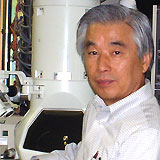
Kavli Prize
Encyclopedia
The Kavli Prize was established in 2005 through a joint venture between the Norwegian Academy of Science and Letters
, the Norwegian Ministry of Education and Research
, and The Kavli Foundation
. The main objective for the Prize is to honor, support and recognize scientists for outstanding scientific work in the fields of astrophysics
, nanoscience and neuroscience
and award three international prizes every second year. The Kavli Prize was awarded the first time in Oslo, 9 September 2008. The Prizes were presented by His Royal Highness Haakon, Crown Prince of Norway
. Each of the three Kavli Prizes consists of a gold medal, a scroll, and a cash award of US $1,000,000.
The Kavli Prize in Nanoscience is awarded for outstanding achievement in the science and application of the unique physical, chemical, and biological properties of atomic, molecular, macromolecular, and cellular structures and systems that are manifest in the nanometre scale, including molecular self-assembly, nanomaterials, nanoscale instrumentation, nanobiotechnology, macromolecular synthesis, molecular mechanics
, and related topics.
The Kavli Prize in Neuroscience is awarded for outstanding achievement in advancing our knowledge and understanding of the brain and nervous system, including molecular neuroscience, cellular neuroscience, systems neuroscience, neurogenetics, developmental neuroscience, cognitive neuroscience, computational neuroscience, and related facets of the brain and nervous system.
These distinguished panels of international scientist’s reviews and recommend the prize winners on basis of a nomination process. The Norwegian Academy of Science and Letters administer the selection process and announce the prize winners.
Norwegian Academy of Science and Letters
The Norwegian Academy of Science and Letters is a learned society based in Oslo, Norway.-History:The University of Oslo was established in 1811. The idea of a learned society in Christiania surfaced for the first time in 1841. The city of Throndhjem had no university, but had a learned...
, the Norwegian Ministry of Education and Research
Norwegian Ministry of Education and Research
Royal Norwegian Ministry of Education and Research is a Norwegian responsible for education, research and kindergartens. The ministry was established in 1814, and since October 18, 2007 led by Tora Aasland and Kristin Halvorsen in 2009. The department reports to the legislature...
, and The Kavli Foundation
The Kavli Foundation
The Kavli Foundation, based in Oxnard, California, is a foundation that supports the advancement of science and the increase of public understanding and support for scientists and their work....
. The main objective for the Prize is to honor, support and recognize scientists for outstanding scientific work in the fields of astrophysics
Astrophysics
Astrophysics is the branch of astronomy that deals with the physics of the universe, including the physical properties of celestial objects, as well as their interactions and behavior...
, nanoscience and neuroscience
Neuroscience
Neuroscience is the scientific study of the nervous system. Traditionally, neuroscience has been seen as a branch of biology. However, it is currently an interdisciplinary science that collaborates with other fields such as chemistry, computer science, engineering, linguistics, mathematics,...
and award three international prizes every second year. The Kavli Prize was awarded the first time in Oslo, 9 September 2008. The Prizes were presented by His Royal Highness Haakon, Crown Prince of Norway
Haakon, Crown Prince of Norway
Haakon, Crown Prince of Norway is the heir apparent to the throne of Norway. On birth he was named Prince Haakon Magnus but it was stressed in the announcement that he would go by the name Haakon. He became Crown Prince Haakon when his father ascended to the crown as Harald V in 1991...
. Each of the three Kavli Prizes consists of a gold medal, a scroll, and a cash award of US $1,000,000.
The Scientific Fields
The Kavli Prize in Astrophysics is awarded for outstanding achievement in advancing our knowledge and understanding of the origin, evolution, and properties of the universe, including the fields of cosmology, astrophysics, astronomy, planetary science, solar physics, space science, astrobiology, astronomical and astrophysical instrumentation, and particle astrophysics.The Kavli Prize in Nanoscience is awarded for outstanding achievement in the science and application of the unique physical, chemical, and biological properties of atomic, molecular, macromolecular, and cellular structures and systems that are manifest in the nanometre scale, including molecular self-assembly, nanomaterials, nanoscale instrumentation, nanobiotechnology, macromolecular synthesis, molecular mechanics
Molecular mechanics
Molecular mechanics uses Newtonian mechanics to model molecular systems. The potential energy of all systems in molecular mechanics is calculated using force fields...
, and related topics.
The Kavli Prize in Neuroscience is awarded for outstanding achievement in advancing our knowledge and understanding of the brain and nervous system, including molecular neuroscience, cellular neuroscience, systems neuroscience, neurogenetics, developmental neuroscience, cognitive neuroscience, computational neuroscience, and related facets of the brain and nervous system.
Selection of the Kavli Laureates
The Norwegian Academy of Science and Letters appoints the three Prize Committees consisting of leading international scientists after receiving recommendations made by the following international academies and equivalent scientific organisations:- The Chinese Academy of SciencesChinese Academy of SciencesThe Chinese Academy of Sciences , formerly known as Academia Sinica, is the national academy for the natural sciences of the People's Republic of China. It is an institution of the State Council of China. It is headquartered in Beijing, with institutes all over the People's Republic of China...
- The French Academy of SciencesFrench Academy of SciencesThe French Academy of Sciences is a learned society, founded in 1666 by Louis XIV at the suggestion of Jean-Baptiste Colbert, to encourage and protect the spirit of French scientific research...
- The Max Planck Society (Germany)Max Planck SocietyThe Max Planck Society for the Advancement of Science is a formally independent non-governmental and non-profit association of German research institutes publicly funded by the federal and the 16 state governments of Germany....
- The National Academy of Sciences (US)United States National Academy of SciencesThe National Academy of Sciences is a corporation in the United States whose members serve pro bono as "advisers to the nation on science, engineering, and medicine." As a national academy, new members of the organization are elected annually by current members, based on their distinguished and...
- The Norwegian Academy of Science and LettersNorwegian Academy of Science and LettersThe Norwegian Academy of Science and Letters is a learned society based in Oslo, Norway.-History:The University of Oslo was established in 1811. The idea of a learned society in Christiania surfaced for the first time in 1841. The city of Throndhjem had no university, but had a learned...
- The Royal Society (UK)
These distinguished panels of international scientist’s reviews and recommend the prize winners on basis of a nomination process. The Norwegian Academy of Science and Letters administer the selection process and announce the prize winners.
Astrophysics
| Year | Laureate | Institution/Country | Rationale | |
|---|---|---|---|---|
| 2008 | Maarten Schmidt Maarten Schmidt Maarten Schmidt is a Dutch astronomer who measured the distances of quasars.Born in Groningen, The Netherlands, Schmidt studied with Jan Hendrik Oort. He earned his Ph.D. degree from Leiden Observatory in 1956.... |
California Institute of Technology, USA | “for their seminal contributions to understanding the nature of quasars” | |
| Donald Lynden-Bell Donald Lynden-Bell Donald Lynden-Bell CBE FRS is an English astrophysicist, best known for his theories that galaxies contain massive black holes at their centre, and that such black holes are the principal source of energy in quasars. He was a co-recipient, with Maarten Schmidt, of the inaugural Kavli Prize for... |
Cambridge University, UK | |||
| 2010 | Jerry E. Nelson Jerry Nelson (astronomer) Jerry Earl Nelson is an American astronomer known for his pioneering work designing segmented mirror telescopes, which led to him receiving the 2010 Kavli Prize for Astrophysics.... |
University of California, Santa Cruz and Lick Observatory, US | “for their contributions to the development of giant telescopes” | |
| Raymond N. Wilson | European Southern Observatory, Garching, Germany | |||
| James Roger Angel | Steward Observatory, University of Arizona, US | |||
Nanoscience
| Year | Laureate | Institution/Country | Rationale | |
|---|---|---|---|---|
| 2008 | Louis Brus | Columbia University, USA | “for their large impact in the development of the nanoscience field of the zero and one dimensional nanostructures in physics, chemistry and biology” | |
 |
Sumio Iijima Sumio Iijima Sumio Iijima is a Japanese physicist, often cited as the discoverer of carbon nanotubes. Although carbon nanotubes had been observed prior to his "discovery", Iijima's 1991 paper generated unprecedented interest in the carbon nanostructures and has since fueled intense research in the area of... |
Meijo University, Japan | ||
| 2010 |  |
Donald Eigler Donald Eigler Donald M. Eigler is a physicist and IBM Fellow at the IBM Almaden Research Center. On September 28, 1989 he achieved a landmark in humankind’s ability to build small structures by demonstrating the ability to manipulate individual atoms with atomic-scale precision... |
IBM Almaden Research Center, San Jose, US | “for their development of unprecedented methods to control matter on the nanoscale” |
| Nadrian C. Seeman | New York University, US | |||
Neuroscience
| Year | Laureate | Institution/Country | Rationale | |
|---|---|---|---|---|
| 2008 | Sten Grillner Sten Grillner Sten Grillner, born 1941, is a professor at the Karolinska Institute's Nobel Institute for Neurophysiology in Stockholm. His research is focused on understanding the cellular bases of motor behaviour; in particular, he has shown how neuronal circuits in the spine help control rhythmic movements,... |
Karolinska Institute, Sweden | “for discoveries on the developmental and functional logic of neuronal circuits” | |
| Thomas Jessell Thomas Jessell Thomas Jessell is a professor of biochemistry and molecular biophysics at Columbia University in New York City. He is known for his work on chemical signals that play a role when nerve cells assemble to form neuronal circuits. In 1994 Jessell was awarded the NAS Award for Scientific Reviewing from... |
Columbia University, USA | |||
| Pasko Rakic | Yale University School of Medicine, USA | |||
| 2010 | Richard H. Scheller | Genentech, US | “for discovering the molecular basis of neurotransmitter release” | |
| Thomas C. Südhof Thomas C. Südhof Thomas C. Südhof is a biochemist well-known for his study of synaptic transmission. Since 1986, Dr. Sudhof's research has elucidated many major proteins mediating presynaptic functions... |
Stanford University School of Medicine, US | |||
| James E. Rothman | Department of Chemistry Yale University, US | |||

